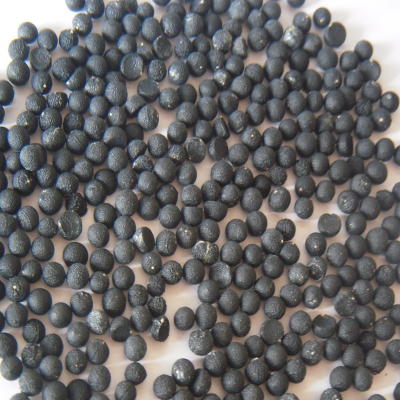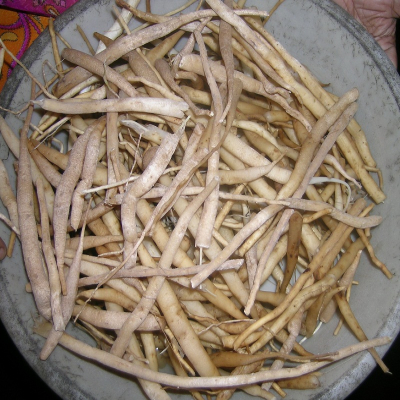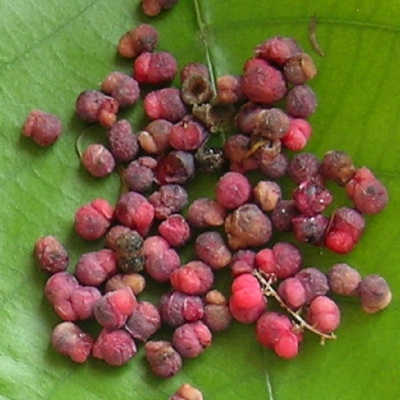Asparagus racemosus Willd.
Synonyms : Asperagus tetragonus
Family : Asperagaceae (Dracaenaceae)
Group : Galactogogue, Uterine tonic, Rejuvenatives
Parts Used : Bark
Vernacular Names :-
| English | : | Asparagus |
| Malayalam | : | Satavari |
| Hindi | : | Satavari |
| Sanskrit | : | Satavari |
| Bengali | : | Shatamuli |
| Gujarathi | : | Ekalkanto |
| Kannada | : | Aheruballi |
| Tamil | : | Ammaikodi |
| Telungu | : | Pilligadalu |
Distribution and habitat: Found wild in tropical and subtropical India including Andaman and Nicobar Islands. Distributed from mean sea level upto 1500 m in the Himalayas from Kashmir eastwards. The crop is cultivated in Kerala, Tamil Nadu, Andhra Pradesh and northern states in India.
Botany: The tuberous succulent roots are 30 cm to 100 cm or more in length, fascicled at the stem base, smooth tapering at both ends. Young stems are very delicate, brittle and smooth.
- Leaf: Reduced to minute chaffy scales and spines; cladodes triquetrous, curved in tufts of 2-6.
- Flower: white fragrant in simple or branched racemes on the naked nodes of the main shoots or in the axils of the thorns.
- Fruits: globular or obscurely 3-lobed, pulpy berries, purplish black when ripe; 4-6 mm diameter.
- Seed: 2 mm in diameter, black in colour and hard with brittle testa.
Chemical constituents:
- Roots contain protein 22%, fat 6.2%, carbohydrate 3.2%, vitamin B 0.36%, vitamin C 0.04% and traces of vitamin A. It contains several alkaloids. Alcoholic extract yields asparagin- an anticancer agent. It also contains a number of antioxytocic saponins like Shatavarin, asparinin, curillin. It contains sarsapogenin
- Leaves contain rutin, diosgenin and a flavonoid glycoside identified as quercetin - 3 - glucuronide.
- Flowers contain quercetin hyperoside and rutin. Fruits contain glycosides of quercetin, rutin and hyperoside while fully ripe fruits contain cyanidin - 3 - galactoside and cyanidin - 3 - glucorhamnoside.
Uses:
- Root is demulcent, diuretic, aphrodisiac, tonic, alterative, antiseptic, antidiarrhoeal, galactogogue and antispasmodic.
- Aerial part is spasmolytic, antiarrhythmic and anticancerous. Bark is antibacterial and antifungal.
- In ayurvedic classics it is prescribed as a cooling agent and uterine tonic. Besides quenching thirst, its root juice helps in cooling down the body from summer heat, curing hyper-acidity and peptic ulcer. It contains good amount of mucilage which soothes the inner cavity of stomach. It relieves burning sensation while passing urine and is used in urinary tract infections. It clears out infections and abnormalities of uterine cavity and hence it is used to rectify infertility in women.
- Main ingredient in ayurvedic medicines like shatavari gulam and shatavari ghrtam.
- Anticancer agent asparagin which is useful against leukaemia.
- Active antioxytoxic saponins which have got antispasmodic effect and specific action on uterine musculature.
- Relaxant to uterine muscles, especially during pregnancy and is used to prevent abortion and pre-term labour on the place of progesterone preparations.
- Its powder boiled with milk is generally used to prevent abortion. It increases milk production in cows and buffaloes. Its preparations in milk help in increasing breast milk in lactating women.
- Its proper use helps in avoiding excessive blood loss during periods.
Agrotechnology
Propagation: Tuberous roots and seeds. Spacing is 60-100 cm.
Manuring: The pit is filled with a mixture of top soil and well decomposed FYM or compost applied at 10-15 t/ha and the seedlings are transplanted. Application of N, P2O5 and K2O at 60:30:30 kg/ha increases the root yield.
After cultivation: Standards are to be provided for training the plant.
Harvesting: After two years provide higher root yield than annual harvests in pots as well as in field experiments. Irrigating the field prior to harvest enables easy harvesting of the root tubers. The average yields is 10-15 t/ha of fresh root tubers though yields over 60 t/ha have been reported.



